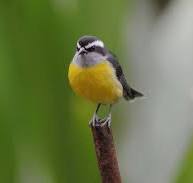The Bananaquit: The U.S. Virgin Islands’ National Bird
The U.S. Virgin Islands, known for their pristine beaches, lush tropical forests, and vibrant culture, have chosen a small but lively bird as their national symbol: the Bananaquit (Coereba flaveola). Despite its modest size, this energetic little bird captures the spirit and essence of the islands with its bright colors, adaptability, and cheerful presence.

Bananaquit at rest
A Symbol of Joy and Resilience
The Bananaquit is not a large or imposing bird. It doesn’t soar majestically like an eagle or strike awe like a falcon. Instead, it embodies a different kind of beauty: the everyday wonder, the joy of simple life, and the strength that comes from being adaptable. These are all traits that mirror the character of the U.S. Virgin Islands themselves.
Also affectionately called the “sugar bird” by locals, the Bananaquit is a common sight throughout the islands, flitting among gardens, parks, and forested areas. Its association with sweetness—both from its diet and its lively personality—makes it a beloved figure among residents and visitors alike.
Physical Characteristics
The Bananaquit is a small bird, measuring about 4 to 5 inches in length. Its most recognizable features are its striking plumage and distinctive curved bill. The upper parts of its body are typically dark gray to black, while its throat and chest are bright yellow. A white stripe runs over each eye like an eyebrow, giving it a cheerful and alert appearance.
Its slender, curved beak is perfectly adapted for feeding on nectar, although the Bananaquit is highly opportunistic and will also feed on fruits, insects, and even small seeds. Its physical adaptability parallels its wide-ranging diet, allowing it to thrive in a variety of environments across the Caribbean and beyond.
Habitat and Range
Though the Bananaquit is found throughout the Caribbean, Central America, and parts of South America, it holds a special place in the hearts of those in the U.S. Virgin Islands. In fact, the Bananaquit has managed to thrive in both urban and wild areas of the islands. It can be seen darting between flowering plants, sipping nectar, or exploring patios and gardens in search of food.
The bird’s ability to live close to human habitations without fear has helped endear it to the population. Unlike many birds that are shy around people, Bananaquits often appear quite fearless, flitting about in plain sight and sometimes even entering homes or hotel balconies in search of sugar or fruit.
Behavior and Diet
One of the Bananaquit’s most fascinating behaviors is its feeding technique. Its curved beak and brush-tipped tongue allow it to sip nectar from flowers, much like a hummingbird. It is often seen hovering briefly to access a blossom, although it more commonly perches while feeding.
In addition to nectar, Bananaquits will readily eat ripe fruit, insects, and even bits of bread or sugar left out by generous humans. This dietary flexibility is a major factor in its survival and abundance across such a wide range of environments.
Bananaquits are lively and constantly moving, hopping quickly from branch to branch or flower to flower. Their cheerful twittering songs fill the air, contributing to the vibrant soundtrack of life in the Virgin Islands.
Cultural Significance
In the U.S. Virgin Islands, the Bananaquit holds deep symbolic significance. It represents resilience, adaptability, and the sweetness of island life. Choosing the Bananaquit as the national bird is an acknowledgment of the beauty found in everyday experiences and the importance of maintaining a close connection with the natural environment.
The bird’s bold presence in human spaces also makes it a reminder of the importance of coexistence between people and nature. Islanders often take pride in the Bananaquit’s presence in their yards and gardens, viewing its visits as a sign of good fortune and prosperity.
Beyond symbolism, the Bananaquit is featured in local art, poetry, and even folklore. Children are taught to recognize the bird’s distinctive colors and song, and it often appears in educational materials promoting environmental awareness and conservation.

Bananaquit feeding
Conservation and Challenges
Fortunately, the Bananaquit is not currently considered an endangered species. Its broad diet and adaptability have helped it maintain stable populations across its range. However, like many island species, Bananaquits are vulnerable to habitat loss, climate change, and the introduction of invasive species.
Development, particularly in coastal and urban areas, can reduce the availability of flowering plants and natural nesting sites. Invasive predators such as rats and feral cats also pose a threat to eggs and young birds.
Conservation efforts in the U.S. Virgin Islands focus not only on protecting specific endangered species but on maintaining healthy ecosystems overall. Native plant restoration, responsible development, and public education all contribute to preserving the habitats that Bananaquits and other native species rely upon.
The Bananaquit’s resilience offers hope: by creating green spaces and preserving native flora, communities can ensure that future generations will continue to enjoy the sight of these bright little birds flitting about their homes and gardens.
Fun Facts About the Bananaquit
-
Scientific Name: Coereba flaveola
-
Family: The Bananaquit is often placed in its own family, Coerebidae, though some taxonomists include it with tanagers.
-
Longevity: In the wild, Bananaquits can live several years, though exact lifespans are hard to determine.
-
Breeding: They build spherical nests from grasses and fibers, often hanging from tree branches or tucked into sheltered spots.
-
Social Behavior: Though generally seen alone or in pairs, Bananaquits can form loose groups, especially where food sources are abundant.
Conclusion
The Bananaquit may be small, but it carries a big meaning for the people of the U.S. Virgin Islands. Its vibrant yellow chest and bright demeanor capture the warmth of the islands’ sun and the hospitality of its people. Its adaptability and cheerful presence are constant reminders of the joy found in everyday life and the importance of living in harmony with nature.
Choosing the Bananaquit as the national bird was more than just an aesthetic decision; it was a reflection of the islands’ spirit—a spirit of resilience, brightness, and sweet, enduring beauty.
As you wander the gardens, forests, and streets of the Virgin Islands, listen for the cheerful chirp of the Bananaquit. It’s more than just a bird; it’s a living symbol of the islands’ heart and soul.
